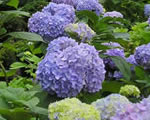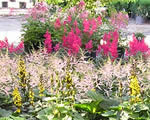|
Rain gardening
has become a popular type of gardening in recent years and for
good reason. Rain gardening is an effective method of controlling
run-off from roofs, driveways and yards. Typically, the run-off
enters our streets and then the storm sewers. This untreated run-off
carries soil, leaves, grass, oil, salt, fertilizer, pet waste,
pesticides and more. Eventually all of this ends up in our rivers,
streams, and lakes. Rain gardens are used to retain run-off and
absorb many of the pollutants into the soil before they have a
chance to reach the rivers, streams, and lakes. This process of
filtration improves water quality, replenishes groundwater, and
reduces the chance of flooding. Rain gardens provide aesthetically
pleasing landscaping and a natural habitat for birds and butterflies.
Rain gardens also promote environmental stewardship and community
pride.
Location
Rain gardens need to be positioned in such a way that they receive
water from downspouts or at a low point in the lawn where drainage
naturally occurs. It is also a good idea to place the rain garden
at least ten feet from the foundation to prevent water from entering
the house.
Size
Rain gardens can be any size or shape. The size of the rain garden
is generally based on the space available; even a small rain garden
will make a difference. However, if water is being diverted to
the area from the roof or other non-porous surfaces, the garden
should be 1/3 as big as the area that drains to it. To figure
the area, multiply the length by the width; this will give the
square footage. If you have clay soil, the rain garden should
be at least half the size of the area being diverted because clay
soils drain slowly.
Soil
To determine the type of soil you have, dig down six inches with
a shovel, and take a small amount of soil from the hole. Moisten
the soil with water. Rub the soil between your fingers and thumb.
If it feels gritty and breaks apart, it is probably a sandy soil.
If it feels smooth and makes a ribbon about one inch long, it
is probably loamy. If it feels smooth and makes a ribbon longer
than one inch before it breaks, it is probably mostly clay.
Creating
the Garden
Dig the edge of the garden and define the shape. Remove the sod.
Remove the soil to a depth of five to seven inches and place the
soil around the outside edge of the garden to create a berm. Be
sure to level out the bottom of the garden and slope the edges
slightly. Plant the flowers and grasses being sure to leave at
least a foot between each plant.
Plants
Native plants are often chosen for rain gardens because they require
little maintenance once established. When considering what to
plant, think about color, height, and bloom time. Here are a few
suggestions:
Full Sun
· Big Bluestem (Andropogon gerardi)
· Little
Bluestem (Schizachyrum
scoparium 'Blaze')
· Marsh Milkweed (Asclepias incarnata)
· Butterfly Milkweed (Asclepias tuberosa)
· Side-Oats Grama (Bouteola curtipendula)
· New Jersey Tea (Ceanothus americanus)
· Prairie Coreopsis (Coreopsis palmata)
· Pale Purple Coneflower (Echinacea pallida)
· Rattlesnake Master (Erygium yuccifolium)
· Prairie Smoke (Geum triflorum)
· Path Rush (Juncus tenuis)
· Prairie Blazing Star (Liatris pycnostachya)
· Wild Bergamot (Monarda fistulosa)
· Purple Prairie Clover (Petalostemum (Dalea)
purpureum)
· Prairie Phlox (Phlox pilosa)
· Prairie
Dropseed (Sporobolus heterolepis)
· Spiderwort
(Tradescantia ohioensis)
· Iron Weed (Vernonia fasciculata)
· Culver's Root (Veronicastrum virginicum)
Part-Shade
· Nodding Onion (Allium cernuum)
· Wild Columbine (Aquilegia canadensis)
· Shooting Star (Dodecatheon meadia)
· Savanna Joe-Pye Weed (Eupatorium purpureum)
· Wild Geranium (Geranium maculatum)
· Prairie Alum Root (Heuchera richardsonii)
· Great St. John's Wort (Hypericum pyramidatum)
· Bottlebrush Grass (Hystrix patula)
· Blue Flag Iris (Iris virginica)
· Cardinal Flower (Lobelia cardinalis)
· Great Blue Lobelia (Lobelia siphilitica)
· Foxglove
Penstemon (Penstemon digitalis)
· Solomon's
Seal (Polygonatum biflorum)
· Heartleaf Alexander (Zizia aptera)
Shade
· Columbine (Aquilegia canadensis)
· Virgin's Bower (Clematis virginiana)
· Virginia Bluebells (Mertensia virginica)
· Wild Blue Phlox (Phlox divaricata)
· Prairie Violet (Viola pedatifida)
Maintenance
After planting, it will be necessary to mulch the plants to retain
moisture and keep weeds down. Water the plants every few days
being sure to check the soil moisture first. If the soil is sandy,
the rain garden may need to be watered more often. If the soil
contains mostly clay, the soil will retain moisture longer; therefore,
less frequent watering is needed. After the plants are established,
the rain garden will not require as much water. However, the garden
should be watched and watered during hot periods. In the colder
months, the vegetation can be left to provide food and shelter
for birds. In spring, cut back the dead vegetation to about six
inches. That is all there is to it.
|



